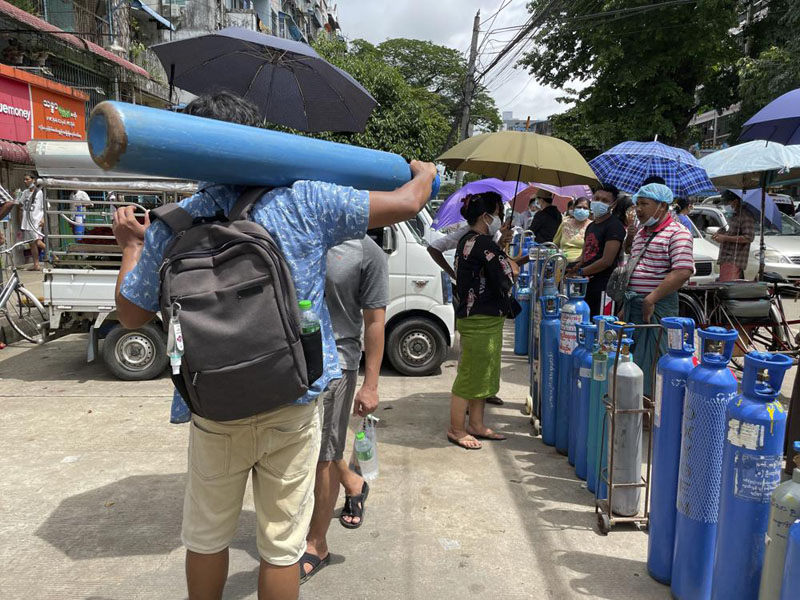

Soe Win stood in line at a plant to buy oxygen for his grandmother, who is struggling with COVID-19 symptoms.
“I have been waiting since 5 in the morning until 12 noon but I’m still in line. Oxygen is scarcer than money,” said the resident of Myanmar’s biggest city, Yangon.
Consumed by a bitter and violent political struggle since the military seized power in February, Myanmar has been slow to wake up to a devastating surge in cases since mid-May. It has left many of the sick like Soe Win’s grandmother to suffer at home if they cannot find a bed at an army hospital, or prefer not to trust their care to the widely disliked government.
Under Aung San Suu Kyi, the civilian leader ousted by the military, Myanmar had weathered its second coronavirus surge beginning in August last year by severely restricting travel, sealing off Yangon, and curbing election campaigning in virus hot spots where lockdowns were imposed.
Suu Kyi appeared frequently on television with stern but empathetic entreaties to the public on how to deal with the situation. Vaccine supplies were secured from India and China. Her ouster came less than a week after the first jabs were given to health workers.
Suu Kyi’s removal by the military sparked widespread protests, and medical workers spearheaded a popular civil disobedience movement that called on professionals and civil servants not to cooperate with the military-installed government.
Military hospitals continued operating but were shunned by many, while doctors and nurses who boycotted the state system ran makeshift clinics, for which they faced arrest. The pace of vaccinations slowed to a crawl, threatening an explosion in infections.
“No wise person with a good heart and a sincere desire for truth would want to work under the junta’s rule,” said Zeyar Tun, founder of the civic action group Clean Yangon who helped out at quarantine centers. “Under Suu Kyi, the government and volunteers worked together to control the disease, but it is difficult to predict what the future holds under military rule.”
Photos and news stories early last week of people lining up to buy oxygen in the city of Kalay in the northwestern Sagaing region brought home the reality that Myanmar’s health care, already one of the world’s weakest, was on its knees.
“From Myanmar, our U.N. colleagues on the ground say they’re concerned about the rapid increase in the number of recorded COVID-19 cases,” U.N. spokesman Stephane Dujarric said in New York. “The U.N. team warns that a major outbreak of COVID-19 would have devastating consequences on both people’s health and on the economy. They stress the importance of resuming the delivery of essential health services, implementing measures to prevent the spread of the virus, and to scale up vaccinations.”
By the end of the week, residents of Myanmar’s two biggest cities, Yangon and Mandalay, were also having trouble finding oxygen supplies.
Myanmar’s new leader, Senior Gen. Min Aung Hlaing, in a Friday meeting on COVID-19 response ordered oxygen plants to work at full capacity, including converting industrial oxygen for the needs of patients.
Investment and Foreign Trade Minister Aung Naing Oo followed up on Saturday with an announcement that the government is dropping all duties and licensing requirements for the import of oxygen concentrators — devices that generate oxygen.
The Health Ministry on Saturday reported a record 4,377 new confirmed cases for a total of 188,752, as well as a record 71 deaths, bringing the toll to 3,756. The number of tested people found to be infected is hovering around 25%, and equally alarming is how quickly the numbers have been rising.
The data on vaccinations is not very clear, but it appears that as of last month, only 3.5 million doses had been administered to the country’s 55 million people, meaning a maximum of 3.2% of the population would be fully vaccinated with two doses.
According to Johns Hopkins University, the seven-day rolling average rose from 1.18 cases per 100,000 people on June 25 to 6.08 cases per 100,000 people on July 9. In the same period, deaths jumped from 0.01 per 100,000 people to 0.08.
Even those numbers are likely an undercount.
According to aid group Relief International, Myanmar’s major challenges are a lack of adequate screening, testing capacity and availability of vaccines.
The Health Ministry announced Thursday night that all schools would be closed for two weeks. Stay-at-home orders had already been issued for badly hit neighborhoods in several cities, including Yangon, and basic field hospitals set up.